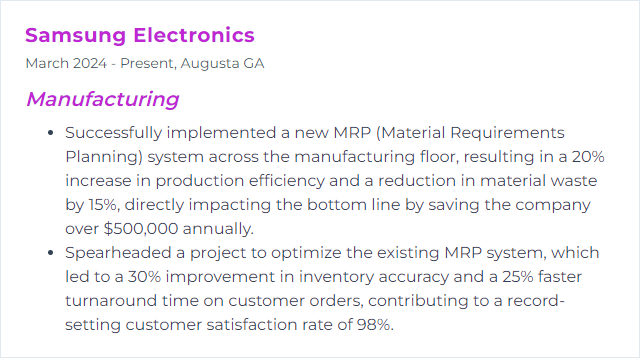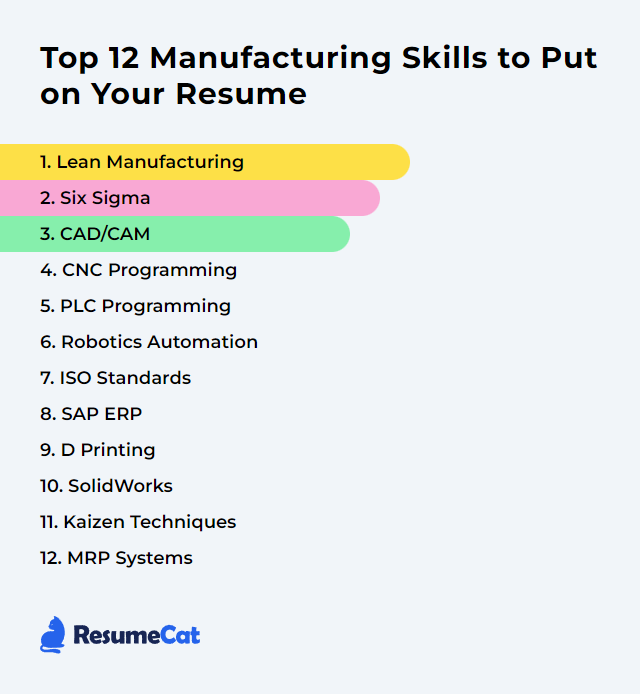Top 12 Manufacturing Skills to Put on Your Resume
In today’s job hunt frenzy, the right manufacturing skills on your resume can tilt the odds. Show the right mix, and hiring managers pause. This guide highlights a dozen core capabilities that consistently matter in modern plants and production floors—and how to present them so they pop.
Manufacturing Skills
- Lean Manufacturing
- Six Sigma
- CAD/CAM
- CNC Programming
- PLC Programming
- Robotics Automation
- ISO Standards
- SAP ERP
- 3D Printing
- SolidWorks
- Kaizen Techniques
- MRP Systems
1. Lean Manufacturing
Lean Manufacturing is a disciplined way to strip out waste and friction while boosting flow. Less clutter, fewer delays, tighter quality. It’s about value for the customer and steady, relentless improvement.
Why It's Important
Lean drives faster throughput, fewer defects, and lower costs. Customers get better quality sooner. The business gets resilience and a sharper competitive edge.
How to Improve Lean Manufacturing Skills
Keep pruning waste and elevating process flow. Useful levers include:
Value Stream Mapping: Map each step end to end; cut what doesn’t add value. Simplify handoffs. Reduce queues.
5S Methodology: Sort, Set in order, Shine, Standardize, Sustain. A clean, labeled, visual workplace makes problems visible—and solvable.
Just-In-Time (JIT): Make only what’s needed, when needed, in the exact quantity. Shrink inventory, expose bottlenecks.
Kaizen: Daily, incremental improvement. Everyone participates. Small wins compound.
Total Productive Maintenance (TPM): Prevent breakdowns, build operator ownership, drive near-zero unplanned downtime.
Poka-Yoke: Mistake-proof steps so errors can’t occur—or get caught immediately.
Standardized Work: Best-known method, documented and repeatable. Baseline for improvement.
Jidoka: Stop for quality. Let equipment detect abnormalities and halt to prevent defects from cascading.
Root Cause Analysis: 5 Whys, fishbone diagrams, fault tree analysis. Fix the source, not the symptom.
Employee Empowerment: Train, trust, and involve the people doing the work. Their insights slash waste fast.
Blend these, and you’ll see cleaner flow, stronger quality, and happier customers.
How to Display Lean Manufacturing Skills on Your Resume
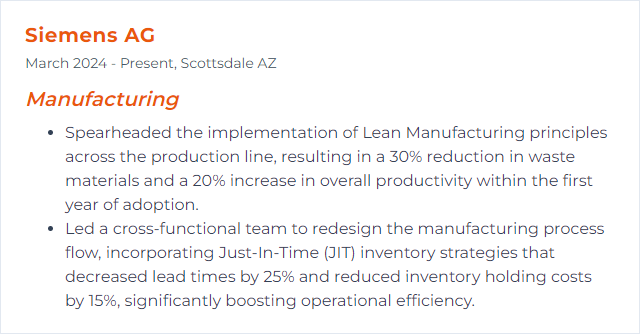
2. Six Sigma
Six Sigma is a data-heavy, statistics-powered approach to reduce variation and defects. Think DMAIC: Define, Measure, Analyze, Improve, Control. Cold numbers, warm results.
Why It's Important
It tightens processes, stabilizes outputs, and cuts cost of poor quality. Customers notice. So does the bottom line.
How to Improve Six Sigma Skills
Sharpen the discipline and the toolkit:
Define with clarity: Lock onto CTQs and measurable goals aligned to customers and strategy.
Measure with rigor: Clean data, capable gauges, solid sampling plans. No fuzzy baselines.
Analyze with depth: Use 5 Whys, regression, DOE, control charts to pinpoint real causes.
Improve decisively: Pilot countermeasures, optimize via DOE, remove waste and variation.
Control sustainably: Standardize, mistake-proof, and monitor with SPC to hold the gains.
Develop teams: Grow Yellow/Green/Black Belt capability; coach problem-solving habits.
Leverage tech: Statistical software, real-time dashboards, automated data capture.
Cultivate CI culture: Celebrate wins, share learnings, keep the cycle turning.
Do this well and defects fall, speed rises, costs retreat.
How to Display Six Sigma Skills on Your Resume
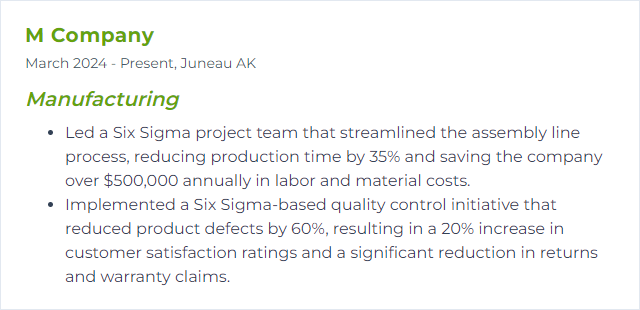
3. CAD/CAM
CAD/CAM pairs design and manufacturing. CAD builds exact 2D/3D models; CAM turns models into machine instructions. Precise geometry in, precise parts out.
Why It's Important
It speeds design cycles, streamlines prototyping, and delivers complex parts at high accuracy—while cutting rework and cost.
How to Improve CAD/CAM Skills
Boost throughput and fidelity:
Stay current: Keep software and hardware updated for performance, features, and compatibility.
Invest in training: Advanced modeling, surfacing, assemblies, and toolpath strategies pay back quickly.
Standardize the workflow: Templates, libraries, naming conventions, and version control prevent chaos.
Tighten collaboration: Use cloud or shared PDM so design and manufacturing iterate in lockstep.
Integrate with ERP/MES: Link BOMs and routings to reduce handoff friction and lead time.
Embrace additive: Fold 3D printing into prototyping to test, learn, and refine faster.
Simulate early: Run FEA, motion, and machining simulations to catch issues before chips fly.
Result: fewer surprises, smoother production.
How to Display CAD/CAM Skills on Your Resume
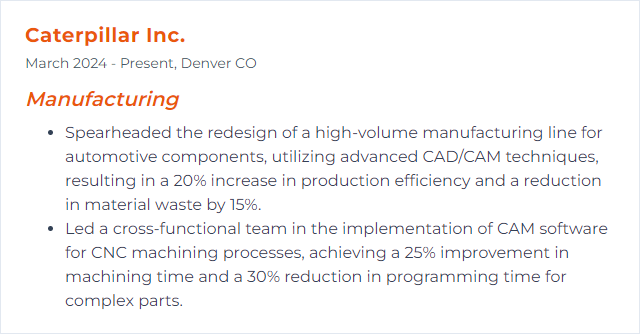
4. CNC Programming
CNC programming writes the code that tells machines how to cut, turn, mill, and shape. G-code, toolpaths, feeds, speeds—the language of precision.
Why It's Important
It unlocks accuracy, repeatability, and speed at scale. Less scrap, more uptime, tighter tolerances.
How to Improve CNC Programming Skills
Trim time and errors, pump up quality:
Continuous learning: Stay sharp on multi-axis strategies, high-speed machining, and new tool coatings.
Simulate before cutting: Use digital twins and verification to prevent collisions and reduce scrap.
Optimize toolpaths: Adaptive clearing, rest machining, and efficient entry/exit moves cut cycle time.
Standardize: Common program structures, macros, and naming save hours and curb mistakes.
Curate tool/material databases: Accurate feeds and speeds by material and tool geometry speed setup.
Close the loop with operators: Feedback from the floor reveals quick wins and subtle pitfalls.
Automate repetitive work: Parameterize families of parts and script routine programming tasks.
Small tweaks here add up to big throughput gains.
How to Display CNC Programming Skills on Your Resume

5. PLC Programming
PLC programming builds the logic that controls machines and lines. Sensors in, decisions made, actuators out—reliably, predictably.
Why It's Important
It’s the backbone of automation—safety, consistency, and flexibility in one place.
How to Improve PLC Programming Skills
Make systems robust and maintainable:
Master the fundamentals: I/O, scan cycles, data types, and common function blocks.
Adopt standards: IEC 61131-3 languages and structured programming for clarity and reuse.
Simulate first: Test logic virtually to de-risk commissioning.
Document obsessively: Clear tag naming, rung comments, revision history—future you will thank you.
Stay vendor-aware: Rockwell, Siemens, and others have unique strengths; learn the ecosystems.
Understand the process: Know the machines, interlocks, and failure modes before writing a single rung.
Keep learning: New hardware, safety PLCs, motion control, IIoT integration—keep pace.
Good logic is clean, safe, and easy to troubleshoot.
How to Display PLC Programming Skills on Your Resume

6. Robotics Automation
Robotics automation brings robots and control systems into the production mix to handle repetitive, precise, or hazardous tasks. Faster cycles. Fewer injuries. Consistent output.
Why It's Important
It raises productivity and quality while shrinking risk. Labor shifts to higher-value work. Throughput climbs.
How to Improve Robotics Automation Skills
Build smarter, safer systems:
Connect with IoT: Real-time data opens predictive maintenance, quick changeovers, and adaptive control.
Add AI/ML where it fits: Vision-guided picking, anomaly detection, and path optimization make cells more flexible.
Strengthen communications: Reliable networks and standardized protocols keep robots and systems in sync.
Engineer for safety: Cobots, light curtains, safe zones, and ergonomic design enable human-robot collaboration.
Train continuously: Programming, teach pendants, safety procedures—keep people fluent.
Design for scalability: Modular cells and quick-change tooling adapt as product mix shifts.
Mind energy use: Select efficient drives and recovery systems to cut power consumption.
Done right, robotics becomes a flexible capacity engine.
How to Display Robotics Automation Skills on Your Resume

7. ISO Standards
ISO standards set common rules for quality, safety, environment, and more. In manufacturing, they anchor consistent processes and reliable outputs—think ISO 9001, ISO 14001, ISO 45001, ISO 13485.
Why It's Important
Compliance boosts trust, unlocks markets, and stabilizes operations. Less variability, clearer documentation, fewer surprises.
How to Improve ISO Standards Skills
Make it a living system, not a binder on a shelf:
- Run gap analyses: Compare current practices to the standard; target the biggest risks first.
- Engage stakeholders: Employees, suppliers, customers—align expectations and responsibilities.
- Train routinely: Quality principles, internal auditing, corrective actions—keep knowledge fresh.
- Strengthen processes: Update procedures, forms, and controls; version them and track changes.
- Measure what matters: KPIs tied to objectives; review them and act.
- Audit internally: Find nonconformities early and fix root causes, not just symptoms.
- Hold management reviews: Evaluate performance, risks, and opportunities regularly.
- Stay current: Monitor updates to relevant ISO standards and revise your system accordingly.
When ISO is woven into daily work, quality becomes habit.
How to Display ISO Standards Skills on Your Resume
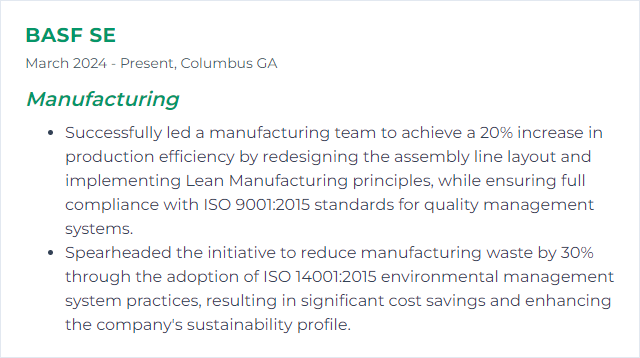
8. SAP ERP
SAP ERP for manufacturing connects production, inventory, procurement, finance, quality, and more in one system. Today that often means SAP S/4HANA, with real-time analytics under the hood.
Why It's Important
Unified data, synchronized planning, and clean transactions. Better scheduling, tighter inventories, faster decisions.
How to Improve SAP ERP Skills
Drive adoption and accuracy:
Standardize processes: Use best practices; trim customizations unless they deliver clear ROI.
Elevate data quality: Strong master data governance—materials, BOMs, routings, vendors.
Train super users: Create internal experts who coach, troubleshoot, and champion improvements.
Integrate the stack: Tie ERP to MES, PLM, CRM for seamless handoffs and traceability.
Adopt advanced capabilities: Embedded analytics, MRP Live, predictive planning, and IoT connectors.
Maintain proactively: Apply patches and upgrades on cadence; regression-test critical flows.
Monitor performance: Track batch job health, interface errors, and user adoption; fix bottlenecks quickly.
A well-tuned ERP turns chaos into coordination.
How to Display SAP ERP Skills on Your Resume

9. 3D Printing
3D printing builds parts layer by layer straight from digital models. Complex shapes, fast iteration, minimal tooling—prototyping and, increasingly, end-use components.
Why It's Important
It slashes lead times, supports customization, and reduces waste. Designs that were once impossible become practical.
How to Improve 3D Printing Skills
Dial in materials, parameters, and finishing:
Tune print settings: Layer height, infill, temperatures, speeds—optimize for strength and surface quality.
Choose the right material: From commodity polymers to high-temp, filled, or metal powders—match properties to the job.
Simulate before build: Predict distortions, supports, and thermal behavior to avoid failed prints.
Improve post-processing: Sanding, chemical smoothing, heat treatment, or machining for final finish and tolerance.
Use multi-material wisely: Combine rigid, flexible, or soluble supports to create smarter parts.
Consider continuous/additive production: For volume, evaluate technologies that minimize stops and starts.
Maintain and calibrate: Bed leveling, nozzle condition, laser optics—consistency lives here.
The magic is in the setup—and the discipline to refine it.
How to Display 3D Printing Skills on Your Resume
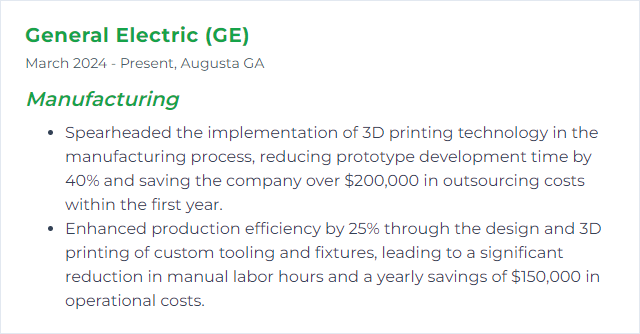
10. SolidWorks
SolidWorks is a widely used CAD platform for modeling parts, assemblies, and drawings, with simulation and CAM integrations that bridge design and manufacturing.
Why It's Important
It accelerates design, validates feasibility, and prepares parts for production—cutting errors and cycle time.
How to Improve SolidWorks Skills
Work faster, smarter:
Leverage SolidWorks CAM: Plan machining right from the model; sync design and manufacturing intent.
Apply DFM tools: Use built-in checks like DFMXpress to catch manufacturability issues early.
Automate with macros/API: Script repetitive steps and standardize feature creation.
Manage data with PDM: Control revisions, references, and access across teams.
Stay current: New releases bring performance and usability gains; train on the features that matter.
Cleaner models, cleaner handoffs, cleaner results.
How to Display SolidWorks Skills on Your Resume

11. Kaizen Techniques
Kaizen is continuous improvement—small, steady changes driven by the people closest to the work. Less waste. Smoother flow. Better morale.
Why It's Important
It builds momentum without big-bang disruptions. Over time, the plant transforms.
How to Improve Kaizen Techniques Skills
Make improvement habitual:
Empower teams: Short, frequent problem-solving sessions. Teach A3 thinking and visual management.
Streamline with 5S and standard work: Orderly spaces reveal abnormalities immediately.
Use simple metrics: Lead time, OEE, first-pass yield—track and talk about them daily.
Listen to customers: Let VOC steer priorities; fix what matters most.
Set SMART goals: Clear targets, quick experiments, candid retrospectives.
Keep cycles short, learning fast, and wins visible.
How to Display Kaizen Techniques Skills on Your Resume

12. MRP Systems
MRP (Material Requirements Planning) calculates what to buy and when, based on demand, BOMs, inventory, and lead times. It keeps materials flowing without drowning in stock.
Why It's Important
Right parts, right time—fewer shortages, fewer expedites, better schedules, lower carrying costs.
How to Improve MRP Systems Skills
Accuracy and integration are everything:
Clean the data: BOM accuracy, lead times, scrap factors, lot sizes—validate relentlessly.
Integrate systems: Sync MRP with ERP, MES, and CRM for real-time visibility.
Forecast better: Blend statistical forecasts with sales/market insight; review bias and error.
Train users: Planners and buyers need clear rules for exceptions, rescheduling, and safety stocks.
Track KPIs: Planner adherence, OTIF, inventory turns, excess & obsolete—inspect and adjust.
Collaborate with suppliers: Share schedules, confirm capacity, and align on lead times and MOQ.
Apply lean principles: Shorter lead times and smaller batches make MRP far more responsive.
Design for scale: Ensure the system handles product proliferation and growth without throttling performance.
When the data is right and the process disciplined, MRP becomes a quiet powerhouse.
How to Display MRP Systems Skills on Your Resume
